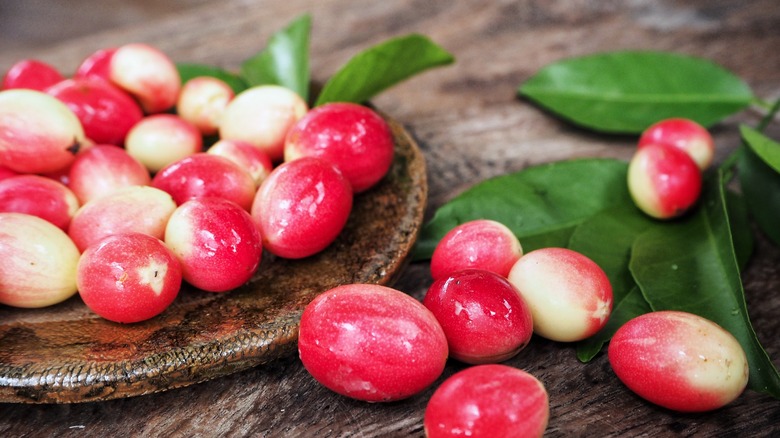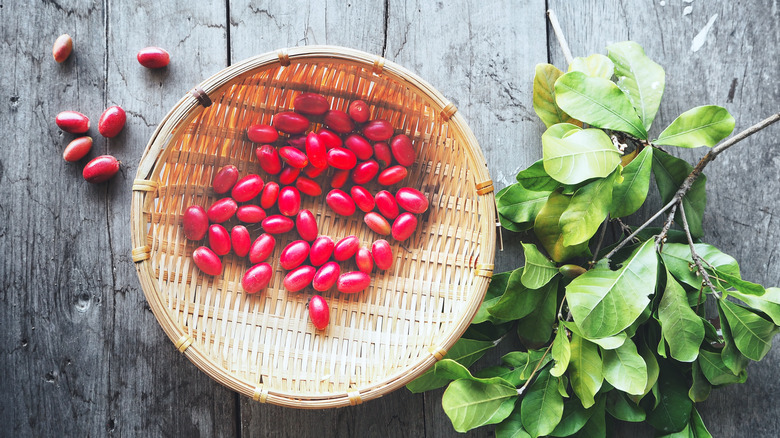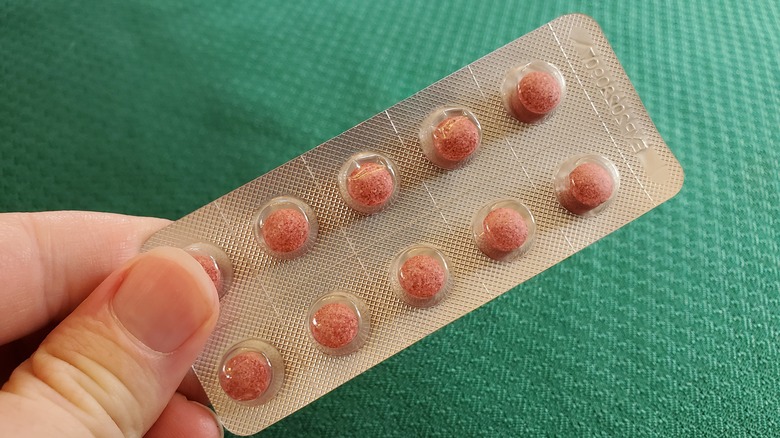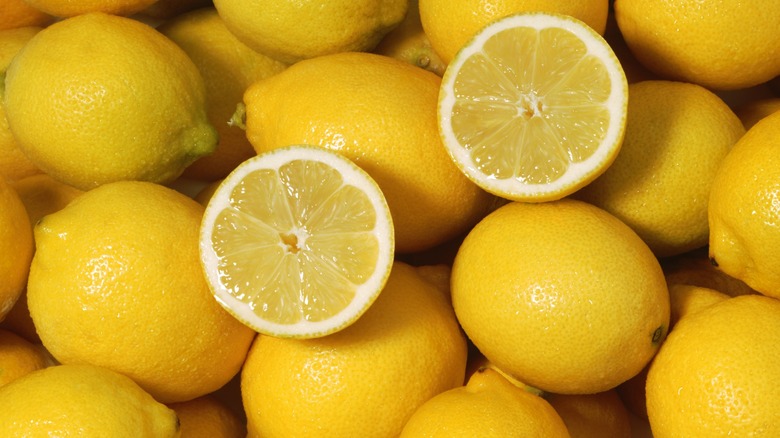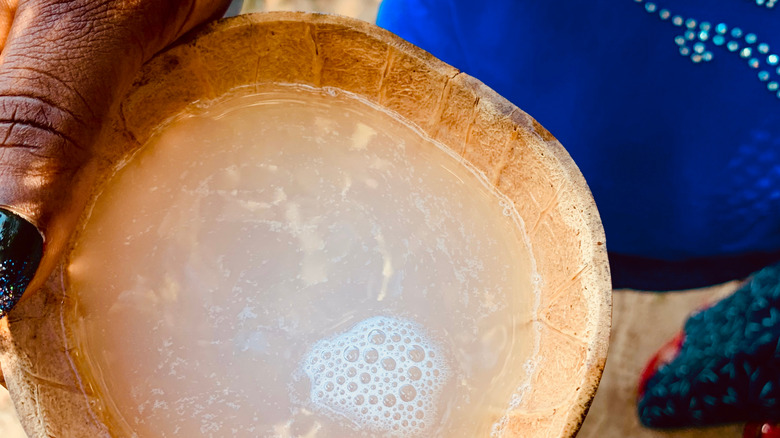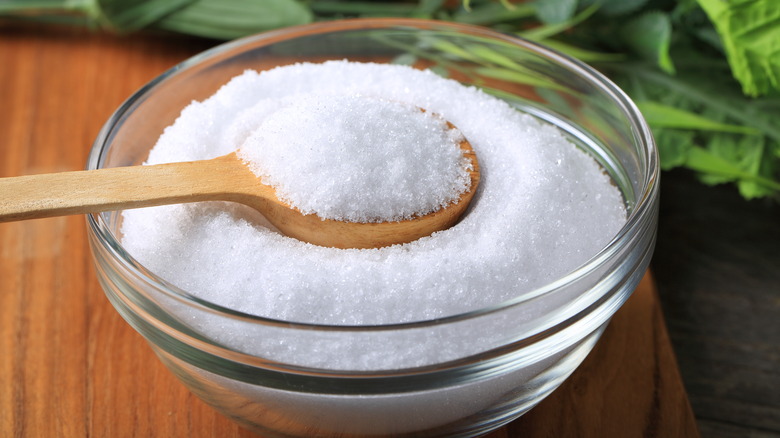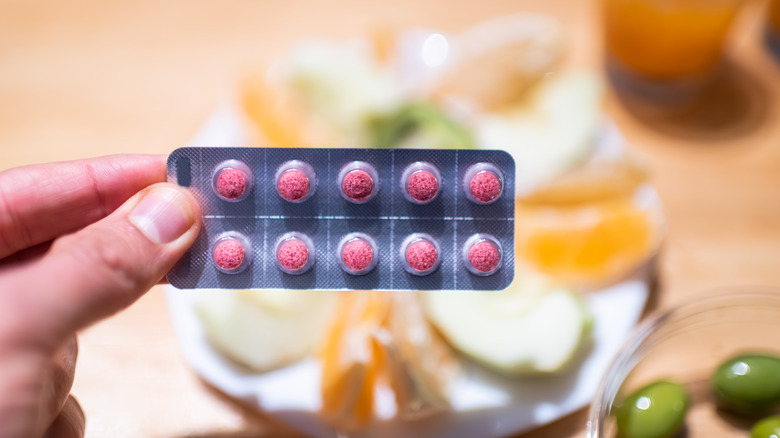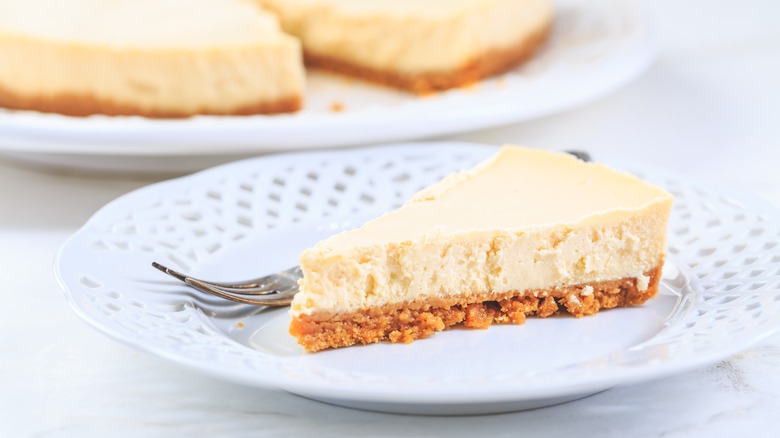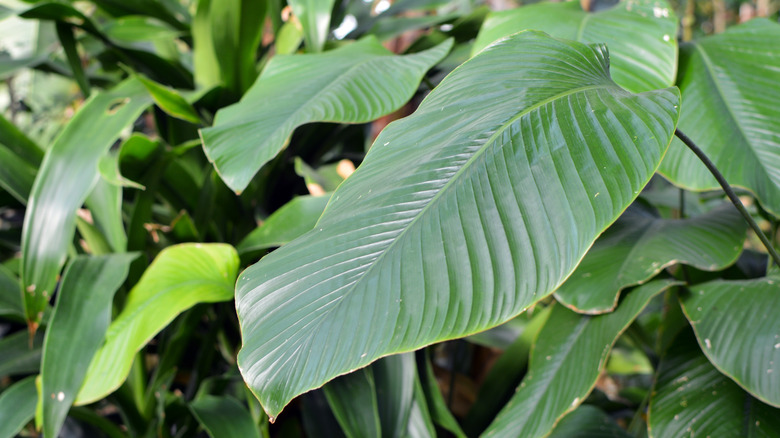What Is Miracle Fruit And How Does It Work?
A food that can make sour foods taste sweet without any sugar may sound like some kind of magic spell, but that's exactly what miracle fruit does. Pop one of these bright red berries into your mouth, chew on it slowly, and for a short time afterward, anything sour will taste sweet instead. Whether you're biting into a pickle from a jar or a slice of fresh lemon, it'll taste just like candy — and not sour candy, either. With the flavor completely changed, lots of foods can taste totally different. You may even notice flavors in everyday foods that you never noticed were there before. However, this isn't magic but science.
The effects of miracle fruit are so dramatic and fun to experiment with that some people have started holding flavor-tripping parties. All you need is a bowl of miracle berries and a selection of sharp-tasting foods to experiment with. These parties kick off with guests chewing on a berry before experimenting with flavors, enjoying familiar foods as if for the first time all over again. Miracle fruit are, as far as scientists know, completely safe, and they even have a few promising therapeutic uses too. If all this makes you curious and you'd like to sample it and have a truly miraculous dinner party, here's everything you need to know.
What exactly is miracle fruit?
The miracle fruit may trick the senses but is quite humble in appearance. It's just a simple red berry, not particularly different from any other. The fruit grows on a small shrub, Synsepalum dulcificum, native to West Africa. It's also not difficult to cultivate. For the green-thumbed, these little bushes can grow very happily in a greenhouse and may produce a couple of flushes of fruit every year. They can even make good houseplants, provided they're kept in a room with plenty of bright light. Those who live in warmer places, like Florida, can even comfortably grow them outdoors. The berries themselves are small and bright red, with shiny skin, each containing a single large seed. They resemble large, elongated cranberries but without the aroma.
To have its unique effect, the fruit's juice needs to come into contact with your tastebuds, so the usual method is to chew on it slowly, moving it around your mouth and letting it coat your tongue. That's all there is to it. Every tastebud it touches will be fooled for 30-60 minutes. As for the seed, you can simply spit that out. Or possibly save it to try and grow your own miracle bush. The fruits themselves work best when fresh, but this isn't an option for everyone. If there's nowhere to buy any actual berries, miracle fruit can also be found on sale online as freeze-dried powder or soluble tablets.
What does miracle fruit taste like?
Surprisingly, while the miracle fruit's main attraction is its ability to make other things taste sweet, it isn't particularly sweet itself. In fact, if not for its miraculous taste-altering effects, this fruit would be quite unremarkable. Despite their inviting color, the berries don't contain much sugar, and while they have a faintly sweet tang to them, there's nothing about their flavor that's particularly distinctive or memorable.
Some people compare the taste of miracle fruit to a bland-tasting cranberry. There's a chance that comparisons like this may be wishful thinking. Scientifically speaking, miracle fruit doesn't really taste like anything at all. An article on PubMed describes it as "nearly tasteless to humans." Even in more concentrated form, as tablets or powder, the flavor is still bland, albeit pleasant and vaguely fruity. You almost certainly won't think much of it until you try tasting anything else and realize it now has a completely unfamiliar flavor.
Nutritional information about miracle fruit
Doctors haven't done many clinical studies on miracle fruit yet, but the few studies that do exist look quite promising. One study involving rats, published in the journal Heliyon, found that the fruit may increase insulin production, helping to regulate blood sugar levels. It's reportedly a good source of vitamins A, C, and E, as well as a good source of leucine — an amino acid that also helps regulate blood sugar and is important for muscle growth. Additionally, it may help improve immune response and have antioxidant, anticonvulsant, and even potentially anticancer properties. However, it's important to remember that while this may all sound very impressive, these properties haven't been confirmed in humans yet.
So far, there isn't enough data to say if eating the fruit could have any negative effects. Promisingly, though, there are no reports of any allergic reactions or toxic effects from it. Generally, miracle fruit is considered safe, and the biggest concern is actually about what you might eat while your tastebuds are under the influence. With all sour foods tasting sweet, it can be very easy to accidentally eat far too much acidic food. Just be mindful of what you're eating, and keep in mind that acidic foods can be just as bad for your teeth as excessive sugar, according to Abbey Road Dental.
How does miracle fruit work?
If you've ever made the mistake of drinking orange juice too soon after brushing your teeth, you'll already know how your sense of taste can be drastically altered for a short amount of time. An ingredient in toothpaste blocks your ability to taste sweet flavors while making bitterness taste far more pronounced. Compounds with this effect are known as taste modifiers, with temporary but dramatic effects.
The taste modifier in miracle fruit is a compound called miraculin. It's a glycoprotein, a type of protein that incorporates sugar molecules into its structure, that temporarily sticks to the sweet taste receptors on your tongue — this is why you need to let the fruit juice coat the inside of your mouth instead of just eating it. The result is that the miraculin fools your tongue, letting you taste all sour flavors as if they were sweet.
The effect lasts until all the miraculin gets washed away by food and saliva. This is why it's most effective if you let juice from the miracle fruit coat your tongue. The more tastebuds it comes into contact with, the more effective it'll be. It also works specifically on sour flavors but leaves others alone. Bitter foods will still taste bitter, and spicy foods will still be spicy. That said, the extra sweetness can help to offset them both. Altering how you perceive sweetness and sourness is enough to profoundly change the flavor profile of many foods.
Flavors to try with miracle fruit
Under the effects of miracle fruit, some people report that even water can taste slightly sweet. For the most dramatic flavor shifts, any food with sour flavors will be a good combination with miracle fruit. Lemons will taste sweet, allowing you to enjoy some delicious flavor subtleties, which are usually masked by the lemons' acidic sharpness. Other citrus fruits are good choices, too — grapefruit will still have some bitterness to it, but its newfound sweetness will counter that very effectively. Milder-tasting fruit like strawberries or tomatoes will taste much sweeter than usual. Meanwhile, fruits that naturally contain sweet and sour flavors, like raspberries and pineapples, can taste so sweet that some people find them overpowering.
While fruits, with their sharpness and subtle flavors, are interesting things to explore with miracle fruit, many other things will now taste unrecognizable. Fermented foods like olives and pickles are fun to experiment with. Condiments like ketchup, mustard, and even vinegar will taste sweet enough that you'll be able to eat them by the spoonful. Some people compare the taste of Guinness to a chocolate milkshake, while Tabasco sauce reportedly tastes a lot like doughnut glaze — though be warned that it'll also be no less spicy.
Traditional uses of miracle fruit
While they may still be largely unknown to most of the world, miracle fruit has been eaten in West and Central Africa for centuries, and in Yoruba, the fruit is known as agbayun. Traditionally, people chew on them before meals to make sour-tasting foods more palatable. Fermented foods can easily become extremely sour, especially in warmer weather, and two such common things are fermented cornbread and sour palm wine — palm wine is a traditional drink, sweet and milky-looking, made from palm sap. This beverage also ferments far more quickly than most others. After only a day, it can go from a pleasant alcoholic drink to something face-scrunchingly sour. Chewing miracle fruit allows the wine to still be enjoyed even when it's past its best.
As well as changing the taste of foods, miracle fruit has also long been used in traditional West African medicine, though this more often uses other parts of the plant. Among other things, the leaves are used to treat diabetes and in post-natal care. The branches of the bush can also be chewed on as a kind of natural toothbrush, while the roots and bark of the miracle fruit bush are also used to treat respiratory ailments and improve male sexual health, detailed in Heliyon. Seemingly, the bark of the bush, in particular, has a reputation as an aphrodisiac.
Miracle fruit as an artificial sweetener
Given its fascinating ability to make things taste sweet, there's no shortage of people who've considered using miracle fruit as an artificial sweetener. In the U.S., the first attempt was in the 1970s, but to no avail. According to Brittanica, the FDA classified miracle fruit extract as a food additive but declared that further safety testing was needed. Their reasoning, not unfairly, was that they didn't have enough information to classify the fruit as GRAS, or generally regarded as safe, and were therefore unable to. The effort to use it commercially was abandoned shortly afterward.
All the same, the idea of using miracle fruit — or, more specifically, miraculin — as a sweetener is an attractive prospect. It can make foods taste rich and sweet without the need to add any sugar at all. It's also a naturally occurring product, making it a more appealing option to people who are distrustful of purely synthetic artificial sweeteners. For those who dislike the taste of most artificial sweeteners, the sweet taste given by miracle fruit is also much closer to the sweetness of real sugar, with no dry aftertaste. While doctors still don't have enough information to say with certainty, so far, miracle fruit seems to be completely hypoallergenic, according to New Food Magazine. While the U.S. may still be uncertain about it, miracle fruit has already been used as a sweetener in Japan.
Miracle fruit for therapy
While for most people, miracle fruit is essentially a fun little novelty; there are some people for whom these unassuming red berries can be truly life-changing. Perhaps the most obvious example is for diabetics. Miracle fruit can allow people with any form of diabetes to enjoy sweet flavors without risking potentially dangerous changes to their blood sugar levels, as claimed by MiraBurst.
For medical reasons, other people can find their sense of taste changes suddenly and substantially. According to the Canadian Cancer Society, this is a common complaint from patients undergoing chemotherapy. All cancer patients have slightly different experiences, but the most common complaints are bitter flavors tasting more pronounced, sweet flavors tasting more muted, and a metallic taste in the mouth. This leads to many people no longer enjoying foods they used to love and losing their appetites as a result. For some of these cancer patients, miracle fruit has been a lifeline. Some report that the fruit allows them to enjoy food again, helping them avoid unhealthy weight loss during their treatment.
Another illness that can cause long-term changes in people's sense of taste is COVID-19. As reported by the BBC, the disease makes some foods taste repulsive for months, and this can reportedly last for over a year and a half in some people, as shown in a study on National Institute on Aging. One researcher in the Guardian noted that miracle fruit may be able to help COVID patients, too. While the fruit can't provide a cure, it could potentially make the disease's disastrous effects easier to manage.
Using miracle fruit in food
As such an unusual little fruit, plenty of people will no doubt be curious to try using miracle fruit in their cooking. However, enthusiastic chefs should be warned that the most important thing is not to actually cook it. The miraculin that causes the fruit's fabulous effects doesn't handle temperature changes well. Both hot and cold will denature the protein, making it lose its effects. As a result, the fruit is only available extremely fresh. They don't last long, so you're unlikely to find these berries in supermarkets anytime soon.
The fresh fruit may be difficult for most people to find. After all, they aren't widely grown. A much more accessible option is to use freeze-dried miracle fruit powder, which retains its taste-changing magic and can be bought online. For adventurous chefs, it's possible to use miracle fruit to recreate some sumptuous dessert flavors while using some not-particularly indulgent ingredients. With miracle fruit, you can take some low-fat sour cream and a slice of lemon and easily give it the flavor of a rich cheesecake.
Other miracle fruit
While miracle fruit usually refers to berries from the Synsepalum dulcificum bush, some other fruits share the same name. Confusingly, they both also have unusual taste-related effects. One comes from a plant named Gymnema sylvestre, which can reportedly help to reduce blood sugar levels, according to Healthline. The leaves of this plant are also sometimes used to fight sugar cravings — they contain a different taste modifier compound that makes sweet things taste less sweet, making sugary foods less appealing. The fact that it has the opposite effect of miracle fruit seems to be a bizarre coincidence.
Another African fruit also sometimes goes by the name of miracle fruit. Known as katemfe, from a plant more formally known as Thaumatococcus daniellii, this fruit also has a sweet effect, albeit quite different. It contains a protein called thaumatin that gives a sweet taste which slowly builds in intensity the more of the fruit you eat. Because it's a protein, like miraculin, it also gives its sweet taste without any added sugar, and it's been approved as a sweetener in several countries.
